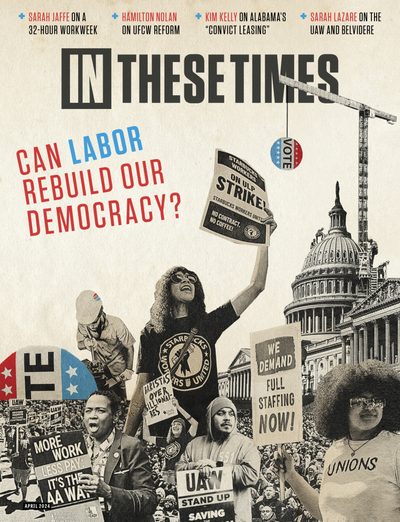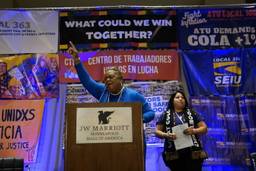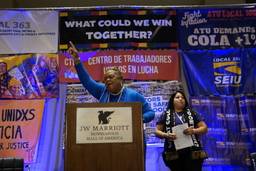A 32-Hour Workweek Is Ours for the Taking
The fight for shorter hours can unify workers everywhere.
Sarah Jaffe
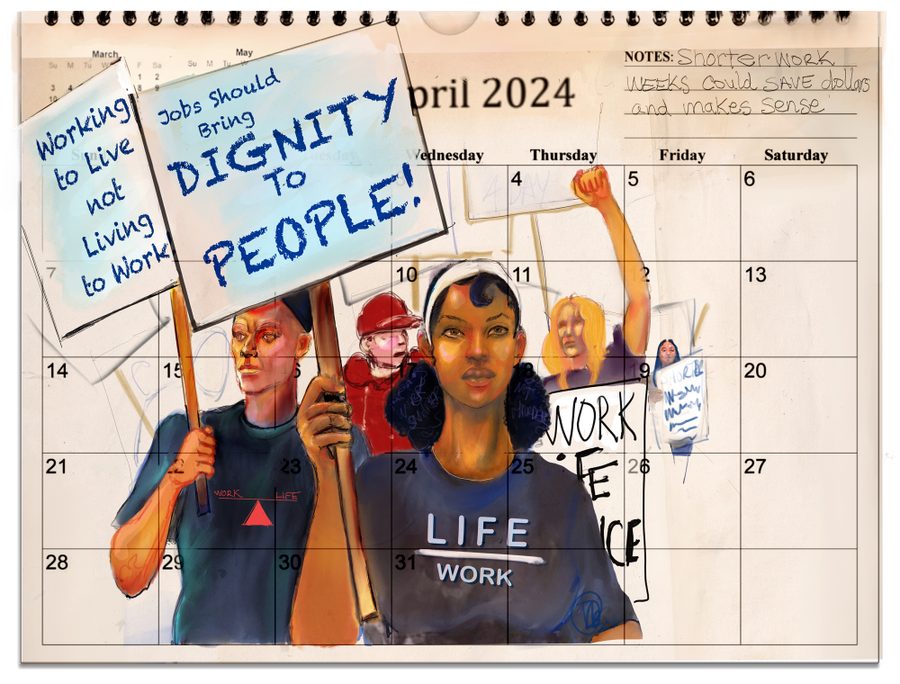
The United Auto Workers won many of their demands in their groundbreaking, six-week strike in 2023, but one of them — despite not making it into their new contracts with the Big Three automakers — has the potential to radically shift organized labor’s priorities and unify an often fractious movement in ways not seen in decades.
The demand is for a 32-hour workweek with no loss in pay. From the beginning of the strike, the audacious proposal captured public attention beyond the usual labor watchers because it upends decades-old expectations of what unions should want, signaling the working class has priorities beyond simply holding onto jobs.
The autoworkers had struck at General Motors in 2019, but despite plenty of energy from the rank and file, a doomed leadership led a lackluster action to a contract that was half-heartedly accepted. Before that, it had been decades of concessions. But in early 2023, democratic reforms in the union swept a new leadership team, under President Shawn Fain, into power with the slogan “No Corruption. No Concessions. No Tiers.” Two-tier status had been a central grievance since the UAW accepted a lower tier for new hires during rampant deindustrialization. At the time, they were told the lower tier was necessary to keep jobs at General Motors, Ford and Chrysler (now owned by Stellantis). But the companies came screaming back to profitability, and workers on the lower tier were still making less for the same work than their more-senior colleagues.
At that time, mass layoffs or concessions weren’t the only ideas floating around, just the ones that won out politically. Economist Dean Baker suggested in articles during the Great Recession that the government subsidize companies to shorten the workweek, spreading the work among more workers and hiring, rather than firing, during the recession. The Obama administration didn’t bite, unions largely didn’t get on board, and we got a long, slow recovery.
The Covid crisis put the issue of working time back on the table. Many “essential” workers — including a wide swath of manufacturing employees— worked forced overtime and risked their lives and health. Across the country and the world, they decided enough was enough.
“It really made people reflect on what’s important in life,” Fain told me in January. Workers were deciding, he said, that working 12-hour days, seven days a week, cobbling together multiple jobs to scrape by “is not a life.” And so the shorter hours demand made its way from grumbling workers to the UAW’s strike demands to major headlines (“Why a four-day workweek is on the table for automakers,” among so many others).
It was “like a bolt out of nowhere,” said Juliet Schor, an economist and sociologist of work at Boston College who has researched and advocated for shorter hours for decades. “It legitimated [the demand] hugely.” Suddenly, New York Times editorial board member Binyamin Appelbaum was endorsing the call and urging President Joe Biden to act on it for workers across industries. “Americans spend too much time on the job,” Appelbaum wrote. “A shorter workweek would be better for our health, better for our families and better for our employers.”
Fain told me that, initially, the UAW was “laughed at, basically, when we put it out there.” Ford CEO Jim Farley complained to CNN that “if we had done that [four-day week]. … We would have gone bankrupt many years ago. … We’d have to close plants and most people would lose their jobs.”
In other words, it’s not a complete shock that the 32-hour week was not in the contracts the union won. But Fain doesn’t see it as a mere bargaining chip. Rather, it’s the start of a long-term strategy for the union, one he hopes the rest of labor will pick up: “I really felt it was imperative to get the dialogue going again, to try to fight for a shorter workweek and get the public thinking along those lines.”
Work-life balance was on the autoworkers’ minds as the union prepared for bargaining — long hours, overtime (whether voluntary or forced) and the ongoing mental health crisis.
“The ability for an autoworker to provide for a family or even oneself has been more and more difficult,” Charles Mitchell, a veteran Stellantis worker in Detroit, told The Guardian. “All the while companies are becoming more profitable and making shareholders richer while forcing mandatory 60- to 70-hour workweeks in assembly plants.”
“Our work lives and the conditions in this nation, in this world, are what lead to a lot of these mental health issues,” Fain said. “Jobs should bring dignity to people.” Too many people, he said, labor constantly, with no time off for their families or friends or “just pursuing things that you love doing.” People lose hope, he said, when all they do is work.
When he’s talking to high school students at the union’s training center, he talks about the fact that work is a process of selling your time: “The greatest resource that we have on this earth is a human being’s time.” The right wing, he noted, talks about a “right to life” when they’re talking about abortion, but that isn’t the kind of right to life he means. “That’s a right to birth. They don’t give a damn about life,” he continued. What he wants is “a real right to life, valuing a human being’s time, valuing their health and not just when they’re born, but after they’re born and when they get old and are too old to work, too young to die.”
ESSENTIALLY EXPOSED BY COVID
The AFL-CIO adopted a resolution two years ago reasserting that shorter hours should be a priority for the federation that represents 12.5 million workers and they would “aggressively take up the fight for a shorter workweek and earlier retirement.”
Mark Dimondstein, president of the American Postal Workers Union, introduced that resolution on behalf of his 200,000-member union. When we spoke after the new year, he told me, “The collective bargaining process gives unions an opportunity to raise this question up. There are other ways too, such as legislation, working with allies, taking it to the streets and so on.”
Just as Fain found lessons in Covid, Dimondstein noted the global pandemic brought us new language about postal workers and so many other working people, one that perhaps unintentionally inspired a new militancy on the shop floor: “We are essential, we are key and we deserve better.”
Schor, too, saw that new common sense everywhere. When her book The Overworked American first came out in 1991, the conversation was very different, but now, she said, it seems people think, “It’s too much. What’s happened to us, the people in this country? We’ve been asked to do something that’s not fair. People are exhausted.”
During the pandemic, as I have written many times, workers realized their bosses didn’t care if they died. “We lost a lot of members that went to work and caught Covid and died, and one worker dying, that’s one too many,” Fain told me. “But meanwhile, the leadership of the Big Three, they’re working from home for two and three years.”
Pushed not just to keep working but to do so for longer hours in more dangerous conditions, many workers began to push back. Even before the pandemic, Donna Jo Marks, a worker at Nabisco’s plant in Portland, Ore., explained, they’d worked 12 days on, then two days off. But once Covid hit, she said, “Sometimes we would work 28 days straight and everyone above us thought, ‘Oh, well, you guys are getting compensated for it,’ — but at what cost?” For a little while, they got $2 an hour extra hazard pay, she said, but that stopped after a few months. “It just was an ugly time and people were tired and it wasn’t safe.”
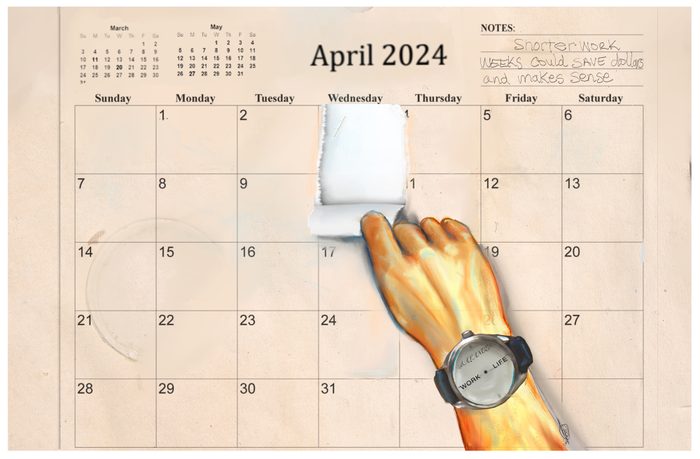
Marks and her coworkers were part of the earlier pandemic strike wave, in which formally and informally organized workers went on strike against the Covid-induced speedup of work. At Nabisco, they struck for more than five weeks and won some concessions on working time, and then, Marks explained, the state legislature passed a bill further restricting the use of forced overtime for bakery workers. Nurses, teachers, warehouse workers, farmworkers and retail workers all took action around safety and the intensification of work. Demanding safety precautions, Florida farmworker Oscar Otzoy told me in 2020, “We’re seen as essential workers, but we’re not taken into account with the same urgency and the same sense of protections that other workers have. And so we think that it’s time for that to happen, for them to be able to see us.”
Employers might talk about workers being part of the family, Fain noted, but their own families were hardly risking their lives on the assembly line. To him, it dramatized the class difference in America: “The wealthy class, the billionaire class, they have a different set of rules for themselves. And then they expect everybody else to follow another set of rules that they exploit. And we’ve been conditioned as a society to think that’s OK.”
Autoworkers, Fain continued, had worked so-called alternate work schedules for years, working two days on, two days off — but those days on were 12-hour shifts, and the days off didn’t line up with the schedules of families and friends. Workers felt like zombies, without enough rest and recreation. And so they brought up scheduling questions again and again when Fain was campaigning and preparing to bargain with the Big Three.
Fain recalled visiting the union’s education center in Michigan’s Black Lake, reading old Solidarity magazines from the UAW’s early days in the 1930s and 1940s. “Our leadership back then was talking about a 32-hour workweek, a 30-hour workweek, and it basically goes back to mastering technology, not letting technology master us.”
When Dimondstein addressed the AFL-CIO convention in 2022 and introduced the shorter workweek resolution, he began the narrative in 1791, when Philadelphia carpenters struck for the 10-hour day. He then spoke about the beginnings of the movement for the eight-hour day and the Haymarket leaders “murdered by the government for their audacity to demand ‘eight hours for work, eight hours for rest, eight hours for what you will.’” May Day, he noted, the international workers’ holiday, came from that particular struggle. But after landing the 40-hour week, Dimondstein noted, “the labor movement largely abandoned the fight for the shorter workweek.”
“It shouldn’t have stopped at eight hours,” he told me in January.
BUSTING THROUGH THE “AFFIRMATION TRAP”
The UAW’s strike this year was a notable shift in strategy for the union, back to a militancy that challenges management’s control over the work process and products. In the “Treaty of Detroit,” the landmark contract that the UAW won from General Motors in 1950, the union made a major decision not to contest so-called management rights. The union restricted its struggles to the size of its slice of the proceeds of workers’ labor, rather than fighting to control the workplace itself. The fight for shorter hours was one of many issues that fell by the wayside in this all-too-brief period of detente.
Fain didn’t directly take aim at the Treaty of Detroit when we spoke, but he did note the philosophy of “working together” with management had been a failure: “It’s a way for the company to make workers think they care about them. And meanwhile, they continue to cut jobs and make life harder on the workers.”
There are far fewer members in the UAW than there were at the height of its power, and more UAW members who aren’t autoworkers at all — the union represents, for example, 48,000 graduate workers and other academics in the University of California system. But the union’s strategy this year was designed to make the most of smaller numbers, holding a rolling strike across the Big Three, taking workers at facilities out on a schedule designed to maximize impact and respond to offers at the bargaining table.
It was a gamble that required more than just militancy to succeed. In order for the “Stand-Up Strike” to work, the union had to find a way around what Joshua Clover, in his book Riot. Strike. Riot., calls the “affirmation trap” — when organized labor “is locked into the position of affirming its own exploitation under the guise of survival.”
The trap is a side effect of deindustrialization under the philosophy of cooperation with management. When companies want to shut plants down anyway, the strike has less power: How do you strike to keep a plant going? Without the leverage that the strike provides, workers end up begging for their jobs and making concessions. But bringing the shorter workweek back into the discussion changes the equation: Rather than importuning the boss to keep everything the same, the shorter workweek reopens the question of workers’ value outside of the plant, suggesting that “less work” might be a goal that workers could embrace too, as long as they get a say in how that work is divided. And rolling strikes concentrated the workers’ power right where and when it would hurt the most. (As a side effect, the UAW did manage to keep a plant open, the Belvidere plant in Illinois, and won the right to strike against future plant closures.)
Fain shrugged off the Ford CEO’s suggestion that a shorter workweek would cause more plant closures: “They’re not going to close a plant because we want a 32-hour workweek. They’re not going to close a plant because we bargained a good contract. They’re going to close the plant because some greedy son of a bitch at the top wants more and they want to do it to somebody else, and they want to exploit them for even less.”
There’s also, of course, the question of technology: Can companies, in fact, replace workers with robots or ChatGPT? This past year was the year that artificial intelligence hype hit the mainstream, but working people across industries have been fighting against the machine since the era of the Luddites. Dimondstein recalled his early days in the postal service, with the introduction of automated equipment like barcodes for sorting mail: “I was on a machine of about 18 to 20 people, a mechanized piece of equipment called the letter-sorting machine. And we were replaced by optical character readers where two people could sort at least as much mail, if not more mail, as the 18 or 20 of us.”
Workers don’t want to go back to the old days, Dimondstein continued, but the real question is, “Who is automation going to serve? We aren’t going to stop the march of technology, but we just don’t want it to serve the profits of Wall Street and the CEOs and these corporations. We want it to make life better for working people.” Automation, he said, could be used to free up time, to pay workers to work less and have more leisure. “There’s the old saying, we’re living to work rather than working to live.”
So far it’s been just the opposite. Postal workers and autoworkers alike work longer hours and forced overtime, and their jobs are harder. But the new common sense around work could help to change that. Other strikes in 2023 — the Writers Guild and Screen Actors Guild, for example — also centered artificial intelligence in their demands.
In Juliet Schor’s research as part of a coalition including researchers from Boston College, Cambridge University and Oxford University and the organization 4 Day Week Global, she continues to find that a four-day workweek brings results to companies around the world that are “off the charts.” Few of the companies are in manufacturing and none are anywhere on the scale of the Big Three, but workers report being happier, more rested and healthier. Some of the companies in their trial program are now coming up on two years and nearly all, she said, are succeeding.
Legislators are starting to take notice. Rep. Mark Takano (D-CA) first introduced a bill in Congress in 2021 to amend the Fair Labor Standards Act, reducing the standard workweek to 32 hours from 40 (meaning all workers who are not overtime exempt would get overtime pay after 32 hours), and he reintroduced it in 2023; Sen. Bernie Sanders has also endorsed the idea. Bills have been introduced in New Hampshire, Massachusetts, Pennsylvania, Rhode Island, New York and Maryland (where a bill was withdrawn to be reworked).
But opposition to those bills is a reminder that if workers want a shorter workweek, they’ll probably have to fight for it. And that’s precisely why the UAW’s strike demand was significant. The union put shorter hours front and center and hasn’t turned away from the issue as it turns, now, to organizing nonunion auto plants across the country, mostly in the South.
Shorter hours can be a unifying demand across plants, across the Big Three and the foreign automakers, where issues might vary but time off can provide a constant. It can link workers across industries and countries, as Schor’s research shows: automakers with postal workers, architects with brewers, legal aid attorneys with graduate students. Dimondstein noted the demand also cuts across political viewpoints.
Around the world, Fain said, workers are waking up to the fact that capitalist priorities are not serving the rest of us, and the shorter workweek can be a demand that the organization of work serve workers’ interests for a change: “It’s not just a UAW issue, it’s not just a union issue, it’s a working class issue. That’s why I think our campaign resonated globally. You have the concentration of wealth going into the hands of fewer and fewer people, and something’s got to give.”
The postal workers are still finalizing their demands as they head into negotiations this year, but Dimondstein said, “There will be some discussions [about shorter hours] going forward because I think we all have to do our part to take up this demand. It’s not going to be changed overnight, but the more we, as the labor movement, unite around core demands like this on all fronts — from collective bargaining to legislation to the streets — then the better chance we’ll have of really concretely winning.”

I hope you found this article important. Before you leave, I want to ask you to consider supporting our work with a donation. In These Times needs readers like you to help sustain our mission. We don’t depend on—or want—corporate advertising or deep-pocketed billionaires to fund our journalism. We’re supported by you, the reader, so we can focus on covering the issues that matter most to the progressive movement without fear or compromise.
Our work isn’t hidden behind a paywall because of people like you who support our journalism. We want to keep it that way. If you value the work we do and the movements we cover, please consider donating to In These Times.
Sarah Jaffe is a Type Media Center Fellow, co-host (with Michelle Chen) of Dissent magazine’s Belabored podcast, and a columnist at The Progressive. She was formerly a staff writer at In These Times and the labor editor at AlterNet. Her previous books are Work Won’t Love You Back: How Devotion to Our Jobs Keeps Us Exploited, Exhausted and Alone and Necessary Trouble: Americans in Revolt, which Robin D.G. Kelley called “The most compelling social and political portrait of our age.” You can follow her on Twitter @sarahljaffe.
